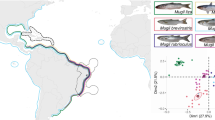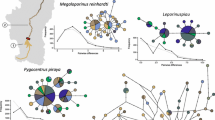Abstract
The organisation of genetic variability is ofprimary importance in designing conservationstrategies. In this context, the conservationunits are often defined using the concept ofEvolutionary Significant Units (ESUs) whatcould appear as a useful guide but are veryrarely used. Another difficulty arises whenspecies hybridise as it is the case in cyprinidfishes for which the debate joins discussionson the species definitions. For example, thevairone, Leuciscus souffia (Teleostei:Cyprinidae) is a protected species (IUCN, Bernconvention, Habitat directive) but currentlegislation does not take into account itsambiguous taxonomic status, neither its geneticvariability nor its ecological preferences. Inthis paper, we examine the genetic structureand phylogeography of the subspecies Leuciscus souffia souffia in its range(France) with a combination of morphology,allozymes and mitochondrial DNA sequences usinganalyses mainly based on AMOVA and nested cladeanalysis. We then decipher the evolutionarybiology of this fish as the combined analysisof morphology, nuclear and mitochondrialmarkers displays decoupling betweenmorphological homogeneity and moderate geneticdifferentiation, suggesting that ManagementUnits (following Moritz' definition) should bedesigned. We conclude by proposing directionsboth for the protection of endangeredpopulations and for the conservation ofevolutionary potential based on theevolutionary dynamics found for the examinedpopulations in the light of the most-often useddefinitions of ESUs.
Similar content being viewed by others
References
Avise JC (2000) Phylogeography: The History and Formation of Species. Harvard University Press, Cambridge, MA.
Avise JC, Hamrick JL (1996) Conservation Genetics: Case Histories from Nature, 2nd edn. Kluwer Academic Publishers, Boston Dordrecht London.
Bianco P (1990) Potential role of the palaeohistory of the Mediterranean and Paratethis basins on the early dispersal of Euro-Mediterranean freshwater fishes. Ichthyol. Explor. Freshwaters., 1, 167–184.
Cavalli-Sforza LL, Edwards AWF (1967) Phylogenetic analysis: Models and estimation procedures. Evolution., 21, 550–570.
Changeux T, Pont D (1995) Current status of the riverine fishes of the French Mediterranean Basin. Biol. Conserv., 72, 137–158.
Chappaz R, Brun G (1993) New data on the biology and ecology of a cyprinid fish from southern Europe-Leuciscus(Telestes) soufia(Risso, 1826). Cr. Acad. Sci. III-vie, 316, 35–41.
Clement M, Posada D, Crandall KA (2000) TCS: a computer program to estimate gene genealogies. Mol. Ecol., 9, 1657–1659.
Cornuet JM, Luikart G (1996) Description and power of two tests for detecting recent population bottlenecks from allele frequency data. Genetics, 144, 2001–2014.
Crandall KA (1996) Multiple interspecies transmissions of human and simian T-cell leukemia/lymphoma virus type I sequences. Mol. Biol. Evol., 13, 115–131.
Crandall KA, Bininda-Emonds ORP, Mace GM, Wayne RK (2000) Considering evolutionary processes in conservation biology. Trends. Ecol.Evol., 15, 290–295.
Crivelli AJ (2002) The role of protected areas in freshwater fish conservation. In: Conservation of Freshwater Fish: Options for the Future (Eds. Collares-Pereira MJ, Cowx IG, Coelho MM), pp. 293–310. Blackwell Science, Oxford.
Douglas ME, Minckley WL, DeMarais BD (1999) Did vicariance mold phenotypes of western north american fishes? Evidence from Gila river cyprinids. Evolution, 53, 238–246.
Dowling TE, DeMarais BD (1993). Evolutionary significance of introgressive hybridisation in Cyprinid fishes. Nature, 362, 444–446.
Durand JD, Templeton A, Guinand B, Imsiridou A, Bouvet Y (1999) Nested clade and phylogeographic analyses of the Chub, Leuciscus cephalus (Teleostei, Cyprinidae), in Greece: Implications for balkan peninsula biogeography. Mol. Phyl. Evol., 13, 566–580.
Excoffier L, Smouse P, Quattro J (1992) Analysis of molecular variance inferred from metric distances among DNA haplotypes: Application to human mitochondrial DNA restriction data. Genetics, 131, 479–491.
Felley JD (1984) Multivariate identification of morphological-Environmental relationships within the Cyprinidae (Pisces). Copeia, 2, 442–455.
Felstenstein J (1995) PHYLIP-Phylogeny Inference Package (Version 3.6). Cladistics, 5, 164–166.
Fisher RA (1930) The Genetical Theroy of Natural Selection. Oxford University Press.
Fraser DJ, Bernatchez L (2001) Adaptive evolutionary conservation: Towards a unified concept for defining conservation units. Mol. Ecol., 10, 2741–2752.
Gerber AS, Tibbets CA, Dowling TE (2001) The role of introgressive hybridization in the evolution of the Gila robustacomplex (Teleostei: Cyprinidae). Evolution., 55, 2028–2039.
Gilles A, Chappaz R, Cavalli L, Lörtscher M, Faure E (1998a) Genetic differentiation between putative subspecies of Leuciscus soufia (Teleostei: Cyprinidae) of the region of the Mediterranean Alps. Can. J. Fish. Aquat. Sci., 55, 2341–2354.
Gilles A, Lecointre G, Faure E, Chappaz R, Brun G (1998b) Mitochondrial phylogeny of the European cyprinids: Implications for their systematics, reticulate evolution and colonization time. Mol. Phyl. Evol., 10, 132–143.
Gilles A, Lecointre G, Miquelis A, Loertscher M, Chappaz R, Brun G. (2001) Partial combination applied to phylogeny of european cyprinids using the mitochondrial control region. Mol. Phyl. Evol., 19, 22–33.
Guinand B, Durand JD, Laroche J (2002) Identifying main evolutionary mechanisms shaping genetic variation of Leuciscus cephalus L. 1758 (Cyprinidae) in Western Greece: Discordance between methods. Cr. Acad. Sci. III-vie, 324, 1045–1060.
Hanfling B, Brandl R (2000) Phylogenetics of european cyprinids: Insights from allozymes. J. Fish Biol., 57, 265–276.
Hubbs CL (1955) Hybridization between fish species in nature. Syst. Zool., 4, 1–20.
Hudson RR (1989) How often are polymorphic restriction sites due to single mutation? Theor. Popul. Biol., 36, 23–33.
Jong H de (1998) In search of historical biogeographic patterns in the western Mediterranean terrestrial fauna. Biol. J. Linn. Soc., 65, 99–164.
Keith P (2000) The part played by protected areas in the conservation of threatened French freshwater fish. Biol. Conserv., 92, 265–273.
Keith P, Allardi J, Moutou B (1992) Livre rouge des espèces menacées de Poissons d'eau douce de France et bilan des introductions. SFF-MNHN / CSP / CEMAGREF / Ministère de l'Environnement. 120 pp.
Keith P, Marion L (2002) Methodology for drawing up a Red List of threatened freshwater fish in France. Aquat. Conserv. Mar. Fresh. Ecosys., 12, 169–179.
Koskinen MT, Haugen TO, Primmer CR (2002) Contemporary fisherian life-history evolution in small salmonid populations. Nature, 419, 826–830.
Machordom A, Nicolas Y, Crivelli AJ (1999) Genetic variability and differentiation in Leuciscus (Telestes) souffia. Taxonomic and conservation inferences. CR. Acad. Sci. III-Vie, 322, 15–28.
MacLachlan GJ (1992) Discriminant analysis and Statistical Pattern Recognition. Wiley & Sons, New York.
Martin JF, Gilles A, Descimon H (2003) Species concepts and sibling species: The case of Leptidea sinapisand Leptidea reali. In: Butterflies: Ecology and Evolution (Eds. Boggs CL, Watt WB,. Ehrlich PR), pp. 459–476. Taking Flight. University of Chicago Press, Chicago.
Meffe GK, Carroll CR (1997) Principles of Conservation Biology, 2nd edn. Sinauer, Sunderland, Massachusetts.
Meyer A (1987) Phenotypic plasticity and heterochrony in Cichlasoma managuense(Pisces, Cichlidae) and their applications for speciation in Cichlid fishes. Evolution, 41, 1357–1369.
Moritz C (1994) Defining evolutionarily-significant-units for conservation. Trends. Ecol. Evol., 9, 373–375.
Moritz C (2002) Strategies to protect biological diversity and the evolutionary processes that sustain it. Syst. Biol., 51, 238–254.
Myers N, Mittermeier RA, Mittermeier CG, da Fonseca GAB, Kent J (2000) Biodiversity hotspots for conservation priorities. Nature, 403, 853–858.
Natura 2000 (1992) Directive 92/43/CEE du Conseil concernant la conservation des habitats naturels ainsi que de la faune et de la flore sauvages-JO L 206 du 22.7.1992 et Bull. 5-1992, point 1.1.132.
Nei M (1978) Estimation of average heterozygosity and genetic distance for a small number of individuals. Genetics, 89, 583–590.
Nei M (1987) Molecular Evolutionary Genetics. Columbia University Press, New York, NY, USA.
Piry S, Luikart G, Cornuet JM (1999) BOTTLENECK: A computer program for detecting recent reductions in the effective population size using allele frequency data. Journal of Heredity, 90, 502–503.
Posada D, Crandall KA, Templeton AR (2000) GeoDis: A program for the Cladistic Nested Analysis of the Geographical Distribution of Genetic Haplotypes. Mol.Ecol., 9, 487–488.
Raymond M, Rousset F (1995) GENEPOP (version 3.3): population genetics software for exact tests and ecumenicism. J. Hered., 86, 248–249.
RNDE (2001) Qualité biologique des cours d'eau en France-Invertébrés-Diatomées-Poissons-Edition RNDE (Réseau National des Données sur l'Eau).
Rozas J, Rozas R (1999) DnaSP version 3: An integrated program for molecular population genetics and molecular evolution analysis. Bioinformatics, 15, 174–175.
Ryder OA (1986) Species conservation and systematics: the dilemma of subspecies. Trends. Ecol. Evol., 1, 9–10.
Sabatier R, Lebreton JD, Chessel D (1989) Principal component analysis with instrumental variables as a tool for modeling composition data. In: Multiway Data Analysis (Eds. Coppi R, Bolasco S), pp. 341–352. Elsevier, Amsterdam.
Saitou N, Nei M (1987) The Neighbor-joining Method: A New Method for Reconstructing Phylogenetic Trees. Mol. Biol. Evol., 4, 406–425.
Salzburger W, Brandstätter A, Gilles A, Parson W, Hempel M, Sturmbauer C, Meyer A (2003) Phylogeography of the vairone (Leuciscus souffia, Risso 1826) in Central Europe. Mol. Ecol., 12, 2371–2386.
Sambrook J, Fritsch EF, Maniatis T (1989) Molecular Cloning: A Laboratory Manual, 2nd edn. Cold Spring Harbor Laboratory Press, New York.
Schneider S, Roessli D, Excoffier L (2000) Arlequin ver.2000: A Software for Population Genetics Data Analysis. Genetics and Biometry Laboratory, University of Geneva, Switzerland.
Shaklee J, Allendorf F, Morizot D, Whitt G (1990) Gene nomenclature for proteine-coding loci in fish. T. Am. Fish. Soc., 119, 2–15.
Statistical Sciences (2000) S-PLUS programmer's Manual Version SP 2000. StatSci, a division of Mathsoft, Inc., Seattle.
Templeton AR (1987) Nonparametric phylogenetic inference from restriction cleavage sites. Mol. Biol. Evol., 4, 315–319.
Templeton AR (1998) Nested clade analyses of phylogeographic data: Testing hypotheses about gene flow and population history. Mol. Ecol., 7, 381–397.
Templeton AR, Crandall KA, Sing CF (1992) A cladistic analysis of phenotypic associations with haplotypes inferred from restriction endonuclease mapping and DNA sequence data. III. Cladogram estimation. Genetics, 132, 619–633.
Templeton AR, Robertson RJ, Brisson J, Strasburg J (2001) Disrupting evolutionary processes: The effect of habitat fragmentation on collared lizards in the Missouri Ozarks. Proc. Nat. Acad. Sci. USA, 98, 5426–5432.
Templeton AR, Routman E, Philips CA (1995) Separating population structure from population history: A cladistic analysis of the geographical distribution of the mitochondrial DNA haplotypes in the tiger salamender, Ambystoma tigrinum. Genetics, 140, 767–782.
Templeton AR, Sing CF (1993) A cladistic-analysis of phenotypic associations with haplotypes inferred from restriction endonuclease mapping. 4. nested analyses with cladogram uncertainty and recombinaison. Genetics, 134, 659–669.
Verspoor E, Hammar J (1991) Introgressive hybridization in fishes: The biochemical evidence. J. Fish Biol., 39, (suppl. A), 309–334.
Ward RD, Elliot NG (1993) Heterozysity and morphological variability in the orange roughy, Hoplostethus atlanticus (Teleostei: Trachichthyidae). Can. J. Fish. Aqua. Sci., 50, 1641–1649.
Wynne IR, Loxdale HD, Brookes CP (1992) Use of a cellulose acetate system for allozyme electrophoresis. In: Genes in Ecology (Ed. Berry RJ, Crawford TJ, Hewitt GM), pp. 494–499. Blackwell, Oxford.
Yoccoz G (1993) Morphometrie et analyses multidimentionnelles. Une revue des méthodes séparant taille et forme. In: Biométrie et environnement (Eds. Lebreton JD, Asselain B), pp. 73–99. Masson, Paris.
Zhang DX, Hewitt GM (1996) Nuclear integrations: challenges for mitochondrial DNA markers. Trends. Ecol. Evol., 11, 247–251.
Author information
Authors and Affiliations
Corresponding author
Rights and permissions
About this article
Cite this article
Salducci, M., Martin, JF., Pech, N. et al. Deciphering the evolutionary biology of freshwater fish using multiple approaches – insights for the biological conservation of the Vairone (Leuciscus souffia souffia). Conservation Genetics 5, 63–77 (2004). https://doi.org/10.1023/B:COGE.0000014054.57397.3f
Issue Date:
DOI: https://doi.org/10.1023/B:COGE.0000014054.57397.3f




